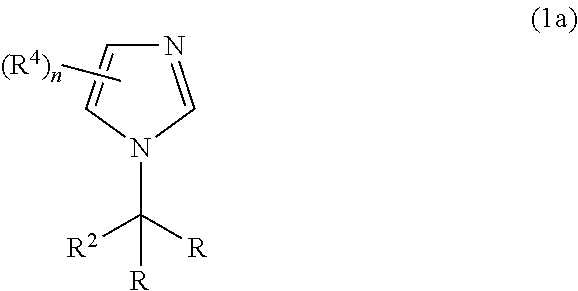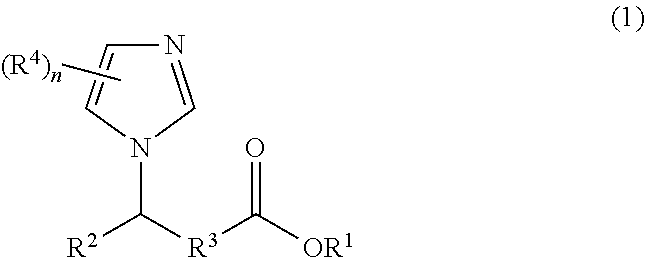Imidazole compound, metal surface treatment liquid, metal surface treatment method, and laminate production method
a technology of metal surface treatment liquid and oxidizing surface, which is applied in the direction of photomechanical equipment, instruments, photosensitive material processing, etc., can solve the problems of difficult soldering on the circuit and the possibility of short circuit of wiring, and achieve the effect of suppressing migration and oxidization of the surfa
- Summary
- Abstract
- Description
- Claims
- Application Information
AI Technical Summary
Benefits of technology
Problems solved by technology
Method used
Image
Examples
example 1-1
[0117]In Example 1-1, an imidazole compound having the following structure was synthesized as an additive 1.
[0118]
[0119]In a dryer, 400 g of a raw material compound having a structure of the above formula (1-(3-(4-methoxyphenyl)acryloyl)-imidazole) was charged together with water, and then heated at 60° C. for a month. The reaction product was subjected to repulp washing with 4,000 g of ethyl acetate at room temperature, followed by filtration and further rinsing twice with 400 g of ethyl acetate to obtain a wet powder 1. The wet powder 1 was subjected again to repulp washing with 4,000 g of ethyl acetate at room temperature, followed by filtration and further rinsing twice with 400 g of ethyl acetate to obtain a wet powder 2. The wet powder 2 was dried under reduced pressure at 40° C. to obtain 300 g of the above objective additive 1 (3-imidazolyl-3-(4-methoxyphenyl)-propionic acid). As a result of the measurement by HPLC, the additive 1 showed a purity of 99.9% or more. The result...
example 1-2
[0124]In the same manner as in Example 1-1, except that 4 g of imidazole was added to 400 g of the raw material compound and the heating time was changed to two weeks from a month, 380 g of an additive 1 was obtained. As a result of the measurement by HPLC, the additive 1 showed a purity of 99.9% or more.
example 1-3
[0125]First, 30 g of the raw material compound used in Example 1-1 was dissolved in 200 g of methanol, and 7 g of potassium hydroxide was added in methanol. Then, the methanol solution was stirred at 40° C. After distilling off methanol, the residue was suspended in 200 g of water. The suspension thus obtained was mixed with 200 g of tetrahydrofuran, followed by stirring and further separation of an aqueous phase. Under ice cooling, 4 g of hydrochloric acid was added. After stirring, 100 g of ethyl acetate was mixed, followed by stirring. After the mixed solution was left to stand, an oil phase was separated. The objective product was crystallized from the oil phase, and the precipitate was recovered to obtain an additive 1.
PUM
| Property | Measurement | Unit |
|---|---|---|
| temperature | aaaaa | aaaaa |
| temperature | aaaaa | aaaaa |
| temperature | aaaaa | aaaaa |
Abstract
Description
Claims
Application Information
 Login to View More
Login to View More - R&D
- Intellectual Property
- Life Sciences
- Materials
- Tech Scout
- Unparalleled Data Quality
- Higher Quality Content
- 60% Fewer Hallucinations
Browse by: Latest US Patents, China's latest patents, Technical Efficacy Thesaurus, Application Domain, Technology Topic, Popular Technical Reports.
© 2025 PatSnap. All rights reserved.Legal|Privacy policy|Modern Slavery Act Transparency Statement|Sitemap|About US| Contact US: help@patsnap.com



